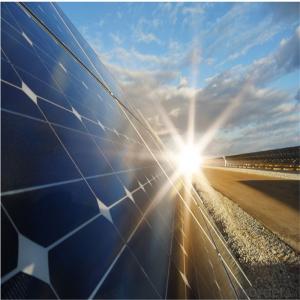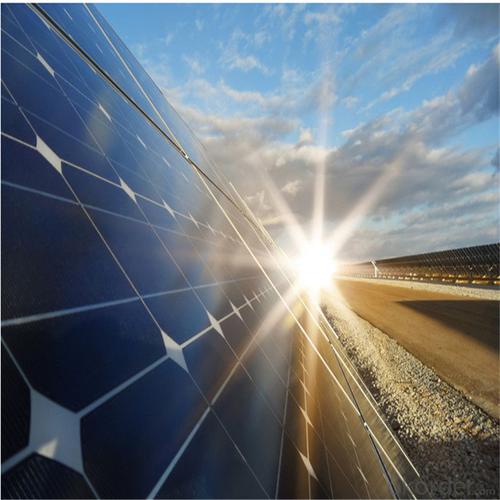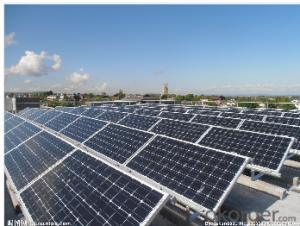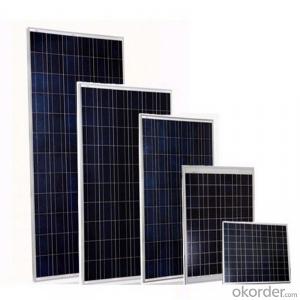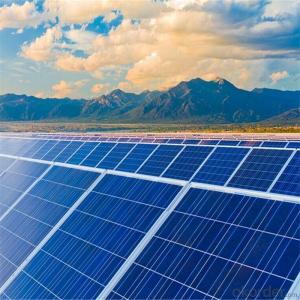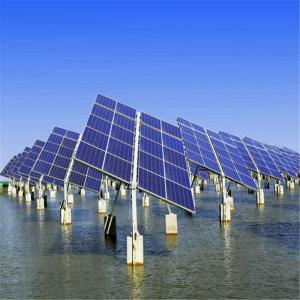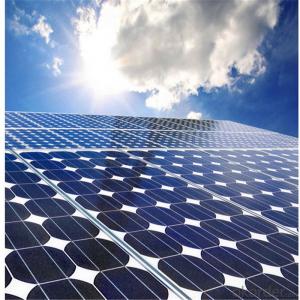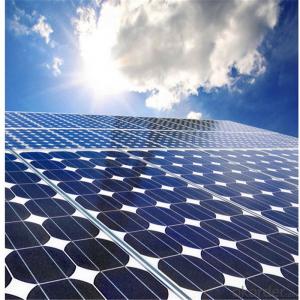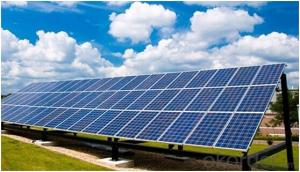105 Watt Photovoltaic Poly Solar Panels for 240 Volts
- Loading Port:
- China main port
- Payment Terms:
- TT OR LC
- Min Order Qty:
- 1000 watt
- Supply Capability:
- 500000 watt/month
OKorder Service Pledge
OKorder Financial Service
You Might Also Like
Specification
Instruction
1) Product name: solar panel / module
2) Solar cell: Mono-crystalline / Poly-crystalline / Amorphous
3) Tempered glass laminated with aluminum frame
4) Life time: 20 - 25 years
5) Temperature co-efficiency: A=+1,46mA B=-79mV, Rp/p=-0.43
6) Power specification at 1kW/m 2, AM 1, 5
7) Output cable: multi contact connectors
8) Construction:
a) Front: High-transmission 32mm tempered glass
b) Back: TPT
c) Encapsulant: EVA
9) Frame: aluminum
10) Certification: CE, TUV
Feature
1. High cell efficiency with high quality crystal silicon materials.
2. Long-term stability and reliability.
3. High Transmission, Low Iron Tempered Glass enhanced stiffness and impact resistance
4. Unique Aluminum frame designed for easy Installation and durable requirement
5. Advanced cell encapsulation materials to offer efficient protection
6. Outstanding electrical performance under high temperature and low irradiance conditions
7. Anti-aging of the EVA(polyethylene - vinyl acetate), high-performance crystalline silicon solar cells, good Weather resistance TPT (fluoroplastics composite membrane) by pyramid ,good Weather resistance and anti-UV, hail, water-proof capacity.Images
Images
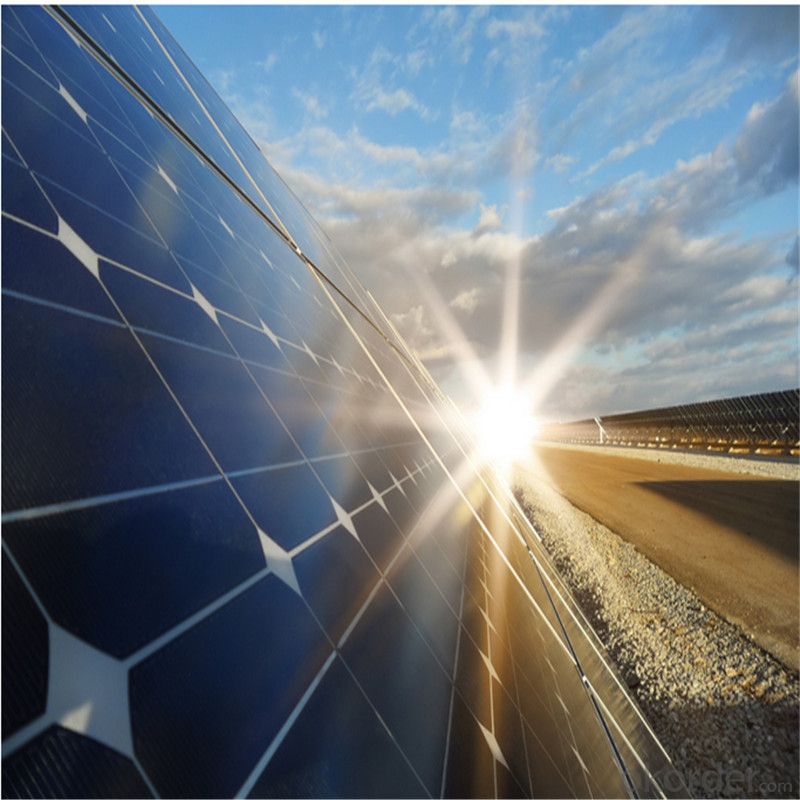
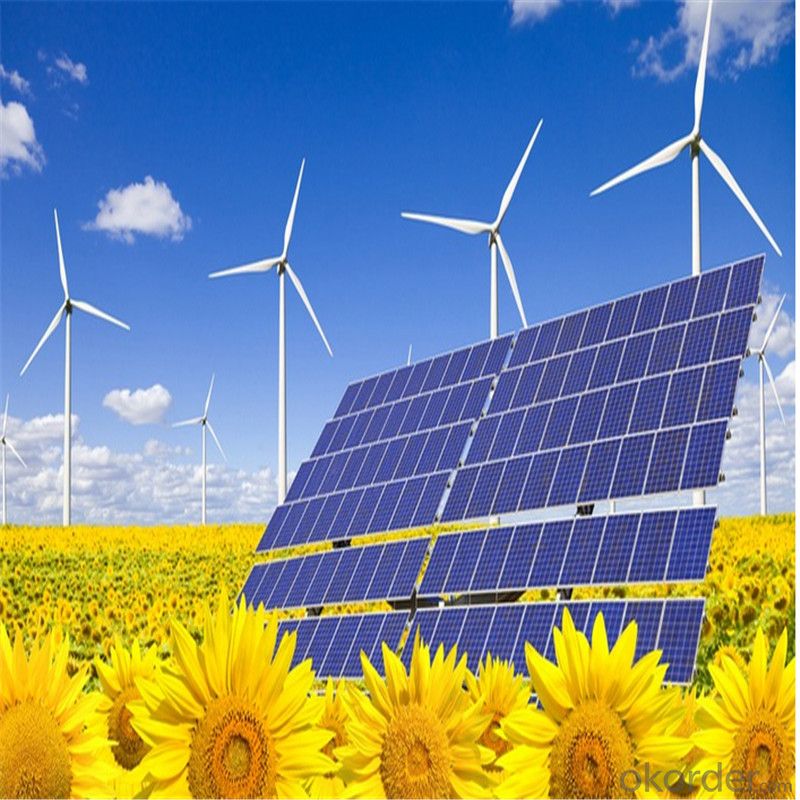
Specification
ITEM NO.: | Poly 156*156 cell ,36pcs . Power 50Wp |
Maximum Power(W) | 80Wp |
Optimum Power Voltage(Vmp) | 17.5V |
Optimum Operatige Current(Imp) | 2.858A |
Open Circuit Voltage(Voc) | 21.6V |
Short Circuit Current(Isc) | 3.12A |
Solar Cell: | 156*156 Poly |
Number of Cell(pcs) | 3*12 |
Brand Name of Solar Cells | JA Cell, Bluesun Cell |
Size of Module(mm) | 790mm*515mm*28mm |
Cable & Connector Type | Pass the TUV Certificate |
Frame(Material Corners,etc.) | Aluminium-alloy |
Backsheet | TPT |
Cell Efficiency for 50W(%) | 15.10% |
Weight Per Piece(KG) | 4.7kg |
FF (%) | 70-76% |
Junction Box Type | Passed the TUV Certificate |
Tolerance Wattage(e.g.+/-5%) | 0~+3% |
Front Glass Thikness(mm) | 3.2 |
Temperature Coefficients of Isc(%) | 0.04 |
Temperature Coefficients of Voc(%) | -0.38 |
Temperature Coefficients of Pm(%) | -0.47 |
Temperature Coefficients of Im(%) | 0.04 |
Temperature Coefficients of Vm(%) | -0.38 |
Temperature Range | -40°C to +85°C |
Surface Maximum Load Capacity | 2400Pa |
Allowable Hail Load | 23m/s ,7.53g |
Bypass Diode Rating(A) | 12 |
Warranty | 100% of 10 years,80% of 25 years. |
Standard Test Conditions | AM1.5 1000W/m² 25 +/-2°C |
Packing | carton or pallet |
1*20' | 20 Pallets / 1600pcs |
1*40'STD | 40 Pallets / 3800pcs |
FAQ
We have organized several common questions for our clients,may help you sincerely:
1). What’s price per watt?
A: It’s depends on the quantity, delivery date and payment terms of the order. We can talk further about the detail price issue. Our products is high quality with lower price level.
2). Can you tell me the parameter of your solar panels?
We have different series of cells with different power output, both from c-si to a-si. Please take our specification sheet for your reference.
3). How do you pack your products?
We have rich experience on how to pack the panels to make sure the safety on shipment when it arrives at the destination.
4). How long can we receive the product after purchase?
In the purchase of product within three working days, We will arrange the factory delivery as soon as possible. The perfect time of receiving is related to the state and position of customers. Commonly 7 to 10 working days can be served.
- Q: is this fact true? - its a limitation to solar panels during summer when it's in extremly hot countrie. I've heard it from my science teacher .. please give detail if you have any and any more benefits/limitations is welcomed .. Thank you :) !
- So what do higher temperatures do to solar photovoltaic panels? As temperatures rise, the efficiency of solar panels decreases. Heat causes electrical resistance to the flow of electrons. On days where the temperature is more than 75 degrees, the electrical resistance makes the voltage fall thereby producing less kilowatts per hour. Your roof is much hotter than temperatures on the ground. That’s why solar panels are not mounted flat to a roof. There’s usually a few inches of spaces between the panels and roof so air flow can easily pass through and cool the panels down. There are some photovoltaic panels that are designed specifically to operate in hotter temperatures. These panels have a higher temperature coefficient. This is especially important in high heat climates like Arizona or New Mexico, but probably wouldn’t make too much of a difference in New England (except maybe this year). If you do live in one of these areas, you should speak to your solar installer to make sure they are using they right equipment for your region. Please note: Solar thermal panels used to heat water can withstand high temperatures without any degradation. In fact, hotter temperatures would actually be better for these types of modules.
- Q: Are there any government incentives or tax credits for installing solar panels?
- Yes, there are indeed government incentives and tax credits available for installing solar panels. These incentives and credits vary by country and even by state within a country. Many governments offer tax credits, grants, or rebates to promote the adoption of solar energy. Additionally, some countries have implemented feed-in tariffs, which allow solar panel owners to sell excess electricity back to the grid at a premium rate. It is advisable to check with local authorities or consult a professional to understand the specific incentives and tax credits available in your area.
- Q: How do solar panels reduce carbon emissions?
- Solar panels reduce carbon emissions by harnessing the power of the sun to generate electricity. Unlike traditional energy sources such as coal or natural gas, solar energy does not produce any greenhouse gases when converted into electricity. By utilizing solar panels to generate power, we can reduce our reliance on fossil fuels and significantly decrease carbon emissions, contributing to the fight against climate change.
- Q: Well I was thinking about the idea of renovating either a smaller school bus or building a tiny house and I was wondering if i can get some information on the size and watts panel should I use or more like how to get that whole solar energy in motion. Any infor and links would help
- I think that typical solar panels are 2'x4' and produce something like 800-000 wh per day. (That's 0.8 - kwh per day.) More in the summer, less in the winter, if they're aimed sort of at the sun. There are newer, more expensive panels that produce more. There are also thin film panels that are less expensive, and probably more sturdy. You then have a couple choices. In a house, you'd have an expensive inverter to connect to the utility power, so you can have power at night when your panels aren't generating anything. In a trailer, you want 2-4-6 deep cycle car batteries to store the power. Then you could have an inverter to convert that power to 20v AC, so you could use normal appliances. Or, you could buy appliances that run on 2 volts DC. Maybe a combination of both. You'll need to figure out how much power you're going to use, so you know how many panels and batteries you're going to need. The calculation is easy. Figuring out how much power you need is hard. You need deep cycle batteries because you can repeatedly charge them way up and run them way down. Ordinary batteries die fairly quickly when you do that.
- Q: I need to find a way to clean solar panels that automated, at best;A way beside using a large 'squeegee'
- Hire Tinkerbell, Disney hasn't had much for her to do lately.
- Q: I have seen DIY software which explains everything for novices. Specifically, how to build your own solar panels and tie them into your home electrical system for about $00 in parts.Has anyone tried doing this? Was it easy?
- I used this youtube video to help me build a 2 volt system. I used this video to build a magnet motor attached to a car alternator, I used an old Ford alternator because they are cheap, then put in the voltage reguialtor that I took out of the same car. I then hooked that up to 6 2 volt batteries in series, then I used 4 500 watt inverters, I got it going about 2 weeks ago, I am waiting to how efficient it will make everything, I also do not have my entire house on it. So far I have hooked up my fridge, deep freeze, 52 plasma tv, and washer. I have not hooked anything else into it yet. I have no idea if it has enough power to turn on full load, like I said I am still toying with it, but it seems to be doing fine.
- Q: what direction should solar panels face to get the best exposure of the sun.
- You orient them to the place where you can get the maximum exposure to the sun. You can get adequate exposure through many degrees. If you really are looking to instal panels then consider an Aussie invention which has a tracking device! Rotating to follow the transit of the sun!
- Q: I would like to connect a solar panel to a small fan. I am not sure as to what is needed to actually quot;connectthe two together. Any help is appreciated.
- If your fan uses a tiny motor like in a cell phone vibrator, you might be able to use just a few solar cells. Otherwise, you might find the voltage and current from a pre-assembled panel, and get a fan that uses less power. You will then likely need electronics to match the two up, and maybe a battery to keep it going when the sun goes down.
- Q: Can solar panels be installed on senior living facilities?
- Yes, solar panels can be installed on senior living facilities. In fact, many senior living facilities have started incorporating solar panels to reduce energy costs, promote sustainability, and provide clean energy solutions. Installing solar panels can help these facilities become more energy-efficient and reduce their carbon footprint. Additionally, solar energy can contribute to a more comfortable and sustainable living environment for senior residents.
- Q: Can solar panels be installed on agricultural or farming operations?
- Yes, solar panels can be installed on agricultural or farming operations. In fact, they are increasingly being adopted in these settings to generate clean and renewable energy. Solar panels can be installed on rooftops of barns, sheds, or other structures, as well as on open fields or unused land. By harnessing solar energy, farmers can reduce their electricity costs, lower their carbon footprint, and contribute to a more sustainable farming practice. Additionally, solar panels can provide shading for livestock or crops, minimizing heat stress and improving overall farm productivity.
Send your message to us
105 Watt Photovoltaic Poly Solar Panels for 240 Volts
- Loading Port:
- China main port
- Payment Terms:
- TT OR LC
- Min Order Qty:
- 1000 watt
- Supply Capability:
- 500000 watt/month
OKorder Service Pledge
OKorder Financial Service
Similar products
Hot products
Hot Searches
Related keywords
